key Lancia Thesis 2008 Owner handbook (in English)
[x] Cancel search | Manufacturer: LANCIA, Model Year: 2008, Model line: Thesis, Model: Lancia Thesis 2008Pages: 386, PDF Size: 4.96 MB
Page 43 of 386
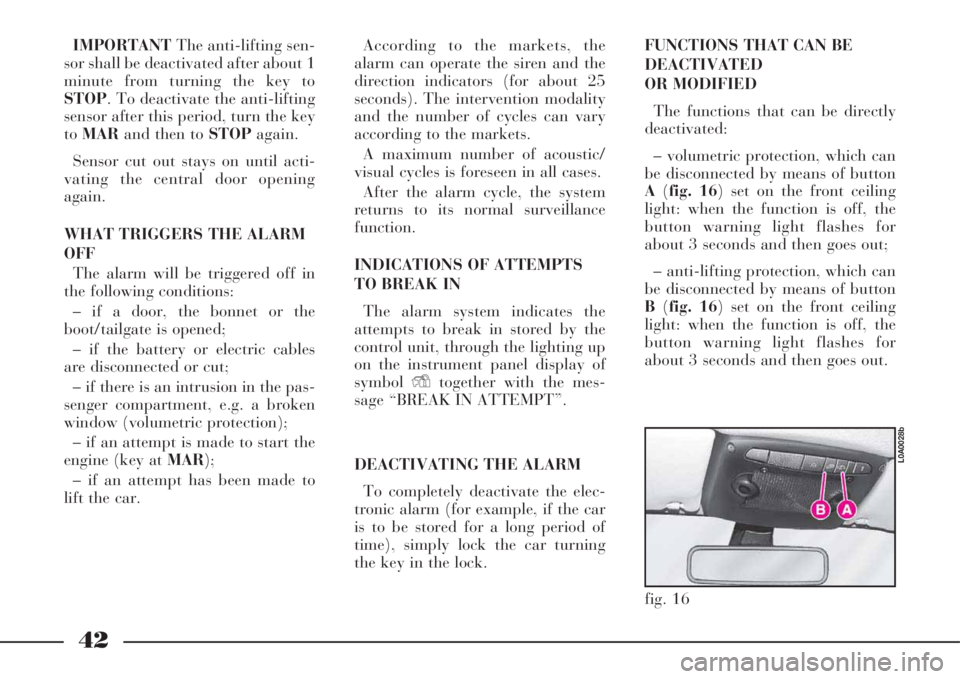
42
IMPORTANTThe anti-lifting sen-
sor shall be deactivated after about 1
minute from turning the key to
STOP. To deactivate the anti-lifting
sensor after this period, turn the key
toMARand then to STOPagain.
Sensor cut out stays on until acti-
vating the central door opening
again.
WHAT TRIGGERS THE ALARM
OFF
The alarm will be triggered off in
the following conditions:
– if a door, the bonnet or the
boot/tailgate is opened;
– if the battery or electric cables
are disconnected or cut;
– if there is an intrusion in the pas-
senger compartment, e.g. a broken
window (volumetric protection);
– if an attempt is made to start the
engine (key at MAR);
– if an attempt has been made to
lift the car.According to the markets, the
alarm can operate the siren and the
direction indicators (for about 25
seconds). The intervention modality
and the number of cycles can vary
according to the markets.
A maximum number of acoustic/
visual cycles is foreseen in all cases.
After the alarm cycle, the system
returns to its normal surveillance
function.
INDICATIONS OF ATTEMPTS
TO BREAK IN
The alarm system indicates the
attempts to break in stored by the
control unit, through the lighting up
on the instrument panel display of
symbolYtogether with the mes-
sage “BREAK IN ATTEMPT”.
DEACTIVATING THE ALARM
To completely deactivate the elec-
tronic alarm (for example, if the car
is to be stored for a long period of
time), simply lock the car turning
the key in the lock.FUNCTIONS THAT CAN BE
DEACTIVATED
OR MODIFIED
The functions that can be directly
deactivated:
– volumetric protection, which can
be disconnected by means of button
A(fig. 16) set on the front ceiling
light: when the function is off, the
button warning light flashes for
about 3 seconds and then goes out;
– anti-lifting protection, which can
be disconnected by means of button
B(fig. 16) set on the front ceiling
light: when the function is off, the
button warning light flashes for
about 3 seconds and then goes out.
fig. 16
L0A0028b
Page 44 of 386

43
The functions that can be modified
through the CONNECT system
menu are:
– boot lock release by actuating
central door opening (*);
– central door and tailgate locking
when the car speed exceeds 20
km/h, without actuation of the
deadlock device.
(*) When this function is discon-
nected to lock the boot lock when
the boot is closed, even if the doors
were closed, the remote control or
the key must be used, as it is nor-
mally the case with the doors; thus,
the boot can be opened with the
handle in the event that the key is
left inside the lock.MINISTERIAL HOMOLOGATION
In the respect of the legislation in
force in each country in the matter
of radio-frequency devices, please
note that the homologation number
is printed on the component for
markets where this is required.
IMPORTANTThe code marking
may also be printed on the transmit-
ter and/or the receiver for ver-
sions/markets where this is required.EASY ENTRY/EXIT
SYSTEM
Versions provided with electric
steering wheel adjustment may also
incorporate the Easy Entry/Exit sys-
tem, which allows the driver to get
into and out of the car with
improved ease.
In the cars provided with this sys-
tem, the steering wheel lifts and the
seat goes back before the driver gets
out of the car.
The function is actuated when the
door is opened but only if the igni-
tion key is at STOPor has been
removed.
When the driver opens the door to
get into the car, both the seat and
the steering wheel have already gone
back. The seat and the steering
wheel will return to their normal dri-
ving position after the driver has sat,
closed the door and turned the key
toMAR.
Page 45 of 386

44
RECOGNITION
SYSTEM(KEYLESS
SYSTEM)
(where provided)
The Keyless System is a recognition
system controlled by device A
(fig. 17), called CID (Customer
Identification Device), which per-
forms the same functions as the key
provided with the remote control
supplied with the car. It does not
require any manual action since it
identifies the person that holds the
device as the owner of the car.
Therefore, it is enough for the dri-
ver to bring the CID device withhimself so that the car can recognize
him, allowing him to get into the car
and start the engine without having
to use the key.
In any case, the CID device is
equipped with three buttons per-
forming the same functions as the
ordinary radio-frequency remote
control that enable the driver to
remotely operate on the car.
Moreover, it includes the key for the
mechanical emergency actuation of
the boot and door locks (in case the
CID device battery or the car battery
are run down).
The buttons perform the following
functions (fig. 18):
– button Bfor remote actuation of
central door opening and the simul-taneous switching off of the elec-
tronic alarm
– button Cfor remote actuation of
central door locking, boot locking
and the simultaneous switching on
of the electronic alarm
– button Dfor remote tailgate
opening
– led E(where required) to indi-
cate code sending to the electronic
alarm system receiver.
To remove emergency keyF
(fig. 19), take off cover G(fig. 20)
by levering at point H.
fig. 17
L0A6007b
fig. 18
L0A0224b
fig. 19
L0A6008b
Page 46 of 386
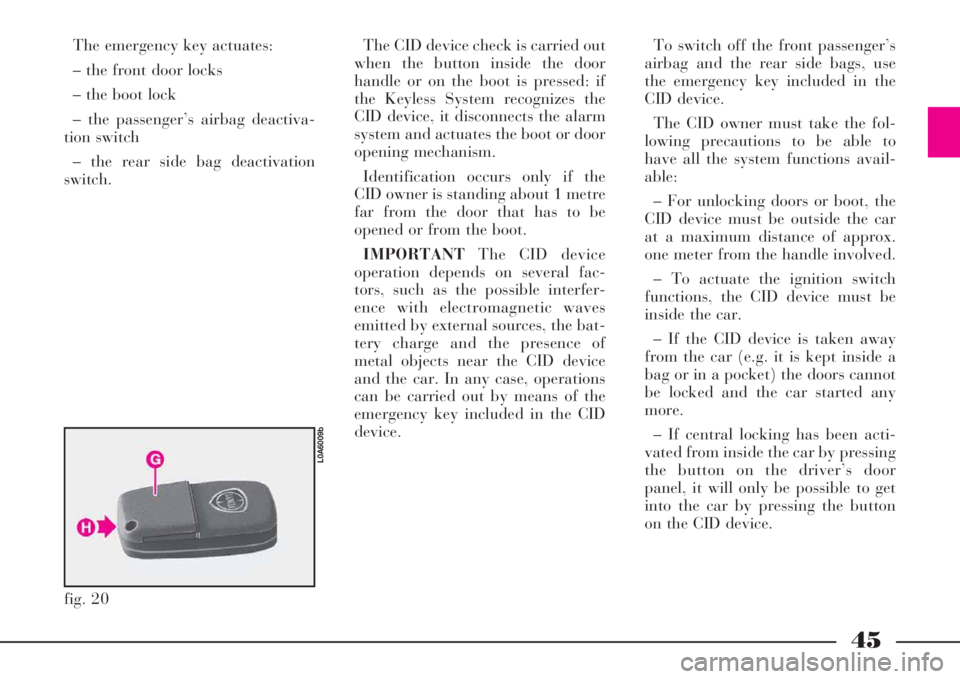
45
The emergency key actuates:
– the front door locks
– the boot lock
– the passenger’s airbag deactiva-
tion switch
– the rear side bag deactivation
switch.The CID device check is carried out
when the button inside the door
handle or on the boot is pressed: if
the Keyless System recognizes the
CID device, it disconnects the alarm
system and actuates the boot or door
opening mechanism.
Identification occurs only if the
CID owner is standing about 1 metre
far from the door that has to be
opened or from the boot.
IMPORTANTThe CID device
operation depends on several fac-
tors, such as the possible interfer-
ence with electromagnetic waves
emitted by external sources, the bat-
tery charge and the presence of
metal objects near the CID device
and the car. In any case, operations
can be carried out by means of the
emergency key included in the CID
device.To switch off the front passenger’s
airbag and the rear side bags, use
the emergency key included in the
CID device.
The CID owner must take the fol-
lowing precautions to be able to
have all the system functions avail-
able:
– For unlocking doors or boot, the
CID device must be outside the car
at a maximum distance of approx.
one meter from the handle involved.
– To actuate the ignition switch
functions, the CID device must be
inside the car.
– If the CID device is taken away
from the car (e.g. it is kept inside a
bag or in a pocket) the doors cannot
be locked and the car started any
more.
– If central locking has been acti-
vated from inside the car by pressing
the button on the driver’s door
panel, it will only be possible to get
into the car by pressing the button
on the CID device.
fig. 20
L0A6009b
Page 47 of 386

46
IMPORTANTDo not remove the
battery from the CID device until
when its replacement is possible.
Where system is unable to identify
the CID device (e.g. the CID battery
is flat) the car can be accessed by
using the emergency key existing
inside the CID itself.
When switched on, the alarm sys-
tem will be actuated when the door
is opened and the siren will start
sounding but will be switched off by
turning the starting knob to MAR.
Car start-up will moreover be possi-
ble by positioning the CID into the
special seat A(fig. 21), located in
front of the gear lever. Under these
conditions, such compartment is the
only position capable of acknowledg-
ing the presence of a CID device
inside the passenger compartment.
fig. 21
L0A0182b
It is advised to always
carry about with you the
CID device, avoiding to
leave it unguarded inside the
passenger compartment, because
in this case any children remain-
ing unguarded inside the car or
unauthorised people could start
the engine.
Do not expose the CID
device to electromagnetic
fields or high-intensity
radio frequency sources, to avoid
operation anomalies. Heavy
shocks or exposure to direct sun-
light could damage the electronic
components of the device.
IMPORTANTDo not lay the CID
device outside the car on the sunroof,
to avoid a fake identification of the
CID itself as if inside the car. It is rec-
ommend to carry about with you the
CID device (e.g. into a pocket). “GARAGE” POSITION
(EMERGENCY ACTUATION)
During emergency or servicing
operations, the CID device shall be
housed in the dashboard central
oddment compartment A(fig. 21) in
front of the gear lever.
The electronic component in the
CID device is of the “passive” type
and does not require dedicated
power supply; it can therefore oper-
ate in “garage” position even if the
CID device battery is run down.
Page 48 of 386
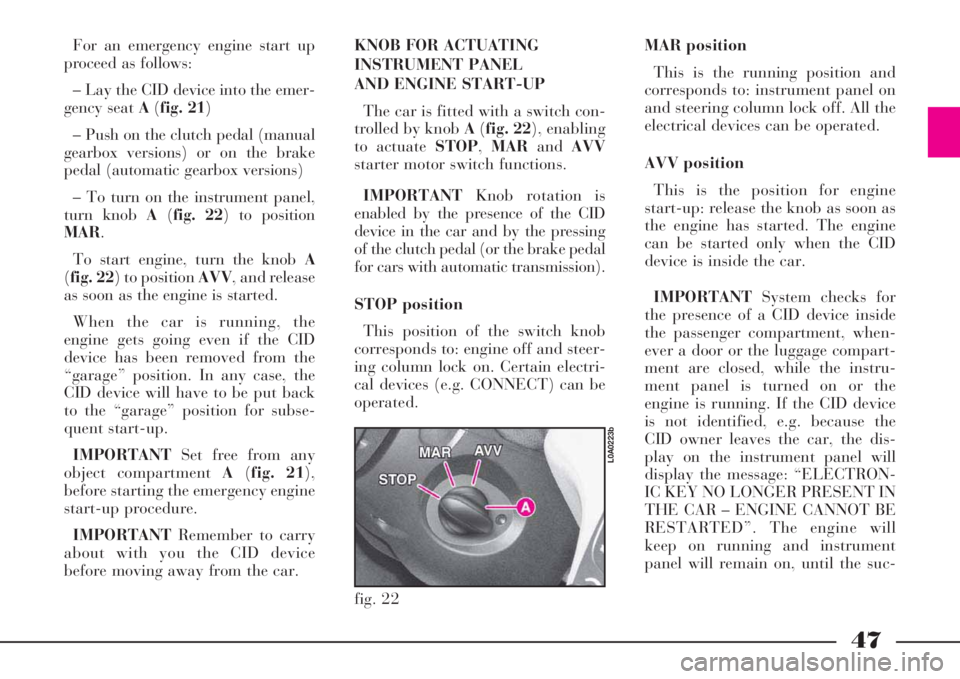
47
For an emergency engine start up
proceed as follows:
– Lay the CID device into the emer-
gency seat A(fig. 21)
– Push on the clutch pedal (manual
gearbox versions) or on the brake
pedal (automatic gearbox versions)
– To turn on the instrument panel,
turn knob A(fig. 22) to position
MAR.
To start engine, turn the knob A
(fig. 22) to positionAVV, and release
as soon as the engine is started.
When the car is running, the
engine gets going even if the CID
device has been removed from the
“garage” position. In any case, the
CID device will have to be put back
to the “garage” position for subse-
quent start-up.
IMPORTANTSet free from any
object compartment A(fig. 21),
before starting the emergency engine
start-up procedure.
IMPORTANTRemember to carry
about with you the CID device
before moving away from the car. KNOB FOR ACTUATING
INSTRUMENT PANEL
AND ENGINE START-UP
The car is fitted with a switch con-
trolled by knob A(fig. 22), enabling
to actuate STOP,MARandAVV
starter motor switch functions.
IMPORTANTKnob rotation is
enabled by the presence of the CID
device in the car and by the pressing
of the clutch pedal (or the brake pedal
for cars with automatic transmission).
STOP position
This position of the switch knob
corresponds to: engine off and steer-
ing column lock on. Certain electri-
cal devices (e.g. CONNECT) can be
operated.MAR position
This is the running position and
corresponds to: instrument panel on
and steering column lock off. All the
electrical devices can be operated.
AVV position
This is the position for engine
start-up: release the knob as soon as
the engine has started. The engine
can be started only when the CID
device is inside the car.
IMPORTANTSystem checks for
the presence of a CID device inside
the passenger compartment, when-
ever a door or the luggage compart-
ment are closed, while the instru-
ment panel is turned on or the
engine is running. If the CID device
is not identified, e.g. because the
CID owner leaves the car, the dis-
play on the instrument panel will
display the message: “ELECTRON-
IC KEY NO LONGER PRESENT IN
THE CAR – ENGINE CANNOT BE
RESTARTED”. The engine will
keep on running and instrument
panel will remain on, until the suc-
fig. 22
L0A0223b
Page 49 of 386
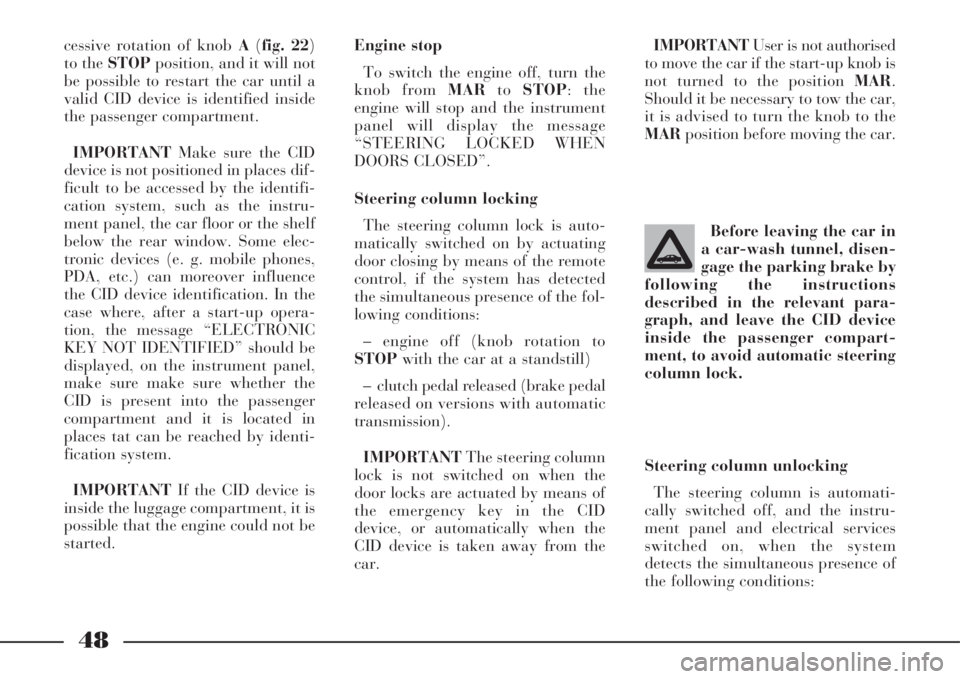
48
Before leaving the car in
a car-wash tunnel, disen-
gage the parking brake by
following the instructions
described in the relevant para-
graph, and leave the CID device
inside the passenger compart-
ment, to avoid automatic steering
column lock.IMPORTANTUser is not authorised
to move the car if the start-up knob is
not turned to the position MAR.
Should it be necessary to tow the car,
it is advised to turn the knob to the
MARposition before moving the car.
Steering column unlocking
The steering column is automati-
cally switched off, and the instru-
ment panel and electrical services
switched on, when the system
detects the simultaneous presence of
the following conditions:
cessive rotation of knob A(fig. 22)
to the STOPposition, and it will not
be possible to restart the car until a
valid CID device is identified inside
the passenger compartment.
IMPORTANTMake sure the CID
device is not positioned in places dif-
ficult to be accessed by the identifi-
cation system, such as the instru-
ment panel, the car floor or the shelf
below the rear window. Some elec-
tronic devices (e. g. mobile phones,
PDA, etc.) can moreover influence
the CID device identification. In the
case where, after a start-up opera-
tion, the message “ELECTRONIC
KEY NOT IDENTIFIED” should be
displayed, on the instrument panel,
make sure make sure whether the
CID is present into the passenger
compartment and it is located in
places tat can be reached by identi-
fication system.
IMPORTANTIf the CID device is
inside the luggage compartment, it is
possible that the engine could not be
started.Engine stop
To switch the engine off, turn the
knob from MARtoSTOP: the
engine will stop and the instrument
panel will display the message
“STEERING LOCKED WHEN
DOORS CLOSED”.
Steering column locking
The steering column lock is auto-
matically switched on by actuating
door closing by means of the remote
control, if the system has detected
the simultaneous presence of the fol-
lowing conditions:
– engine off (knob rotation to
STOPwith the car at a standstill)
– clutch pedal released (brake pedal
released on versions with automatic
transmission).
IMPORTANTThe steering column
lock is not switched on when the
door locks are actuated by means of
the emergency key in the CID
device, or automatically when the
CID device is taken away from the
car.
Page 50 of 386

49
– CID device inside the car
– clutch pedal depressed (brake
pedal on versions with automatic
transmission).
IMPORTANTIf the car battery is
run down, the steering column can-
not be unlocked and the car cannot
be started. In this case, an auxiliary
battery must be connected, in order
to unlock the steering column and
start the engine (see paragraph
“Jump starting”); then, contact a
Lancia Dealershipto have the bat-
tery recharged.DOOR UNLOCKING
TO ACCESS CAR
To perform door unlocking, push on
buttonA(fig. 23front doors -
fig. 24rear doors) in the inside part
of handles. The Keyless System iden-
tifies the CID device, deactivates the
electronic alarm system and operates
the door/s unlocking mechanism.
Leds on door panels will be lit to a
green colour to notice unlocking.
It is possible to set unlocking of dri-
ver’s door only or the contemporary
unlocking of all the doors, by the set-
tings on CONNECT (see the following
paragraph “System Settings”). If “dri-
ver’s door unlocking” is set, it will be
possible to access the passenger com-
partment only through this door; to
unlock the other doors push on but-
tonB(fig. 18) on CID device.
fig. 23
L0A0334b
IMPORTANTIf car or CID device
batteries are flat, to unlock the door
lock it is necessary to operate on the
revolving plug with the emergency
keyF(fig. 19).
IMPORTANTIf the door lock has
been closed with the emergency key F
(fig. 19), Keyless System functions
will temporarily disabled. These func-
tions will automatically be restored at
the next unlocking by pushing button
B(fig. 18) on the CID device or after
the unlocking with the emergency key
F(fig. 19).
fig. 24
L0A0333b
Page 51 of 386
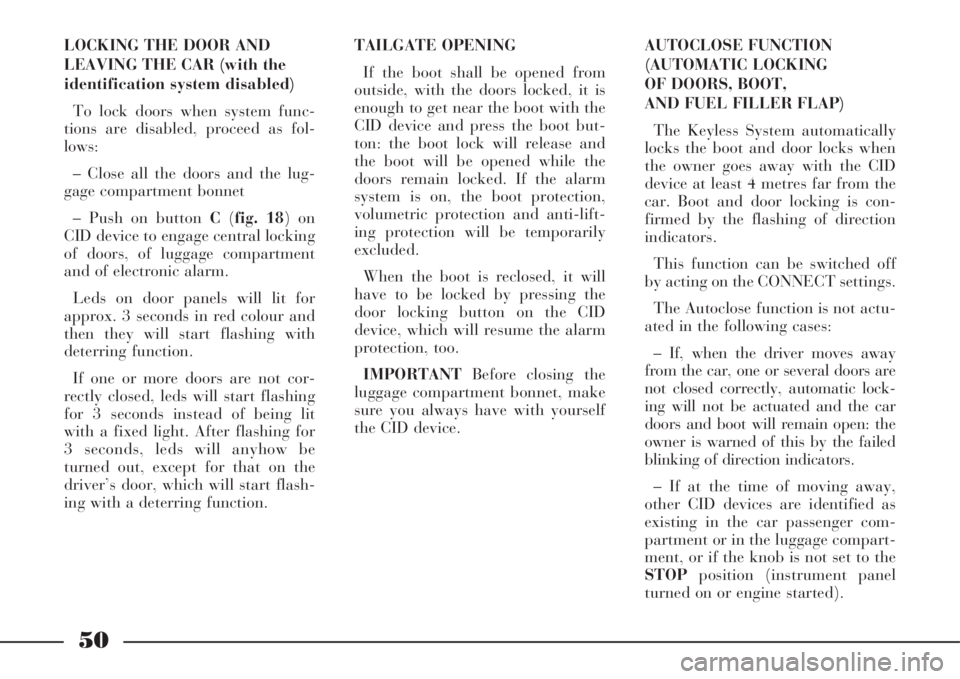
50
AUTOCLOSE FUNCTION
(AUTOMATIC LOCKING
OF DOORS, BOOT,
AND FUEL FILLER FLAP)
The Keyless System automatically
locks the boot and door locks when
the owner goes away with the CID
device at least 4 metres far from the
car. Boot and door locking is con-
firmed by the flashing of direction
indicators.
This function can be switched off
by acting on the CONNECT settings.
The Autoclose function is not actu-
ated in the following cases:
– If, when the driver moves away
from the car, one or several doors are
not closed correctly, automatic lock-
ing will not be actuated and the car
doors and boot will remain open: the
owner is warned of this by the failed
blinking of direction indicators.
– If at the time of moving away,
other CID devices are identified as
existing in the car passenger com-
partment or in the luggage compart-
ment, or if the knob is not set to the
STOPposition (instrument panel
turned on or engine started). LOCKING THE DOOR AND
LEAVING THE CAR (with the
identification system disabled)
To lock doors when system func-
tions are disabled, proceed as fol-
lows:
– Close all the doors and the lug-
gage compartment bonnet
– Push on button C(fig. 18) on
CID device to engage central locking
of doors, of luggage compartment
and of electronic alarm.
Leds on door panels will lit for
approx. 3 seconds in red colour and
then they will start flashing with
deterring function.
If one or more doors are not cor-
rectly closed, leds will start flashing
for 3 seconds instead of being lit
with a fixed light. After flashing for
3 seconds, leds will anyhow be
turned out, except for that on the
driver’s door, which will start flash-
ing with a deterring function. TAILGATE OPENING
If the boot shall be opened from
outside, with the doors locked, it is
enough to get near the boot with the
CID device and press the boot but-
ton: the boot lock will release and
the boot will be opened while the
doors remain locked. If the alarm
system is on, the boot protection,
volumetric protection and anti-lift-
ing protection will be temporarily
excluded.
When the boot is reclosed, it will
have to be locked by pressing the
door locking button on the CID
device, which will resume the alarm
protection, too.
IMPORTANTBefore closing the
luggage compartment bonnet, make
sure you always have with yourself
the CID device.
Page 52 of 386

51
The alarm system, the
steering lock and the
deadlock device are not
actuated by the automatic lock-
ing function.
IMPORTANTPurpose of Autoclose
function is to lock doors, luggage
compartment and fuel filler flap when
owner possessing the CID device,
moves away from the car. In this case
(Autoclose function on), push on but-
tonB(fig. 18) on CID to unlock fuel
filler flap in order to refuel. – If there is a fault in the identifi-
cation system (Keyless System).
– If the CID device battery is flat.
– If the last engine start-up was
performed with the CID device in
the emergency position.
IMPORTANT
– If, after locking the locks, a door
is opened from inside the car, all the
locks will be unlocked.
– If central door opening has been
activated by pressing the CID but-
ton, the Autoclose function (auto-
matic locking) will not be activated.
To activate central locking, press the
relevant button on the CID device.
– When the Autoclose function on,
before leaving the car, make sure
you always have with yourself the
CID device.The Autoclose function can be
influenced by the presence of elec-
tromagnetic noises; in these cases
lock the doors with the remote con-
trol or use the door locks.
CENTRAL LOCKING/OPENING
OF WINDOWS AND SUNROOF
When central door locking is
switched on/off, also the central
locking/opening of the windows and
the sunroof can be controlled, pro-
vided that all the doors are properly
closed.
To actuate central locking of the
windows and the sunroof, keep the
remote control button A(fig. 25)
depressed for more than 2 seconds
after closing the doors: both the win-
dow regulators and the sunroof will
be actuated until they are fully
closed or until the button is released.
fig. 25
L0A0253b